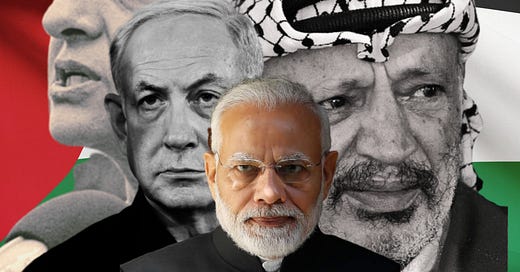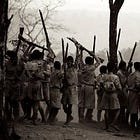Welcome to the Brown History Newsletter. If you’re enjoying this labor of love, please do consider becoming a paid subscriber. Your contribution would help pay the writers and illustrators and support this weekly publication. If you like to submit a writing piece, please send me a pitch by email at brownhistory1947@gmail.com.
Don’t forget to check out our SHOP and our Podcast.

Recommended Reads:
India's Relationship with Palestine: From Solidarity to Silence
The keffiyeh—a black-and-white scarf now synonymous with Palestinian solidarity—adorning countless necks in Washington, DC, in 2024; it reminds me of my childhood in India. I witnessed this symbol of hope and resistance appear on TV screens and in newspapers. Before the age of thirteen, when the internet's knowledge finally reached our home, my understanding of Palestine was distilled into a single, recurring image—a keffiyeh-wearing man with a smiling face who visited India, Yasser Arafat. If you were in India in the eighties and nineties, read the newspapers, or were interested in international affairs—which is all too common for someone from Uttar Pradesh like me—you wouldn't be a stranger to the keffiyeh or Arafat. A man with a complicated legacy, he was not the first to wear the keffiyeh as a symbol of resistance. However, he introduced many to the keffiyeh as a symbol of hope and Palestine's journey to liberation, especially in India. His presence in our national discourse made Palestine’s quest feel close to us. Today, however, India is taking a backseat as this iconic scarf becomes a global emblem of the struggle for Palestinian freedom and human rights. At this juncture, I reflect on Arafat, who famously proclaimed Indira Gandhi his sister, and his relationship with India—as a barometer of India's solidarity with Palestine.







